-
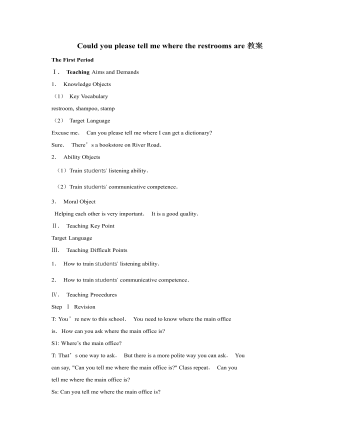
人教版新目标初中英语九年级下册Could you please tell me where the restrooms are教案
Step Ⅰ RevisionCheck homework. Ask a few students to read the article in 3a.Then ask a few students to read their guides.Step Ⅱ Part 1Look at the words in the box. Ask a student to read them. Make sure the students understand the meaning of the words. You are to fill in the blanks with the words. In some cases, students may need to use another form of the word, for example adjusting for tense or subject/ verb agreement.Ask students to fill in the blanks on their own.Check the answers. Step ⅢPart 2Go through the instructions with the class.Look at the example with the students.Ask students what the answer would be.Ask a student to read the question and answer it.Excuse me, could you tell me where the bank is, please?The bank is across the street from the shopping malt.Get students to complete the work in pairs.Check the answers. Ask a few students to read their questions.Step Ⅳ Just for Fun!Ask all the students to read the conversation. Ask: What is funny about this cartoon? Help students to explain. A Martian is a person from the planet Mars.There is no such thing as Martian food on Earth, and the clerk looks silly because he is trying to think of where there is a Martian restaurant.Invite some pairs of students to present this conversation to the rest of the class.Step Ⅴ Summary and HomeworkIn this class, we’ve done much writing practice using the key vocabulary words and the target language presented in this unit. After class, please finish the questions in 2 in your exercise books. Then finish the exercises on pages 47~48 of the workbook as well.The Seventh Period Ⅰ Teaching Aims and Demands1. Knowledge Objects(1) Key Vocabularyimage, adventure, jealousy, hero, crime, journey, brave, no longer, show interest in, take it easy, become interested in, plain looks(2)Text:Grown-ups like cartoons, too.2. Ability Objects(1) Fast-reading to get a general idea of the text.(2) Careful-reading to get the detailed information in the text.
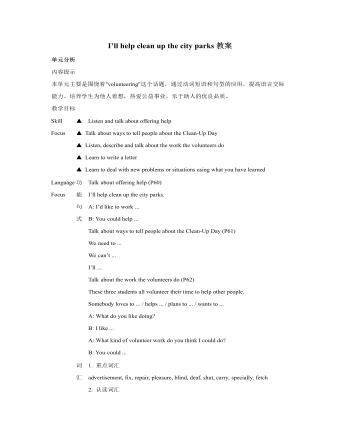
人教版新目标初中英语九年级下册I’ll help clean up the city parks教案
Talk about offering help (P60)I’ll help clean up the city parks.A: I’d like to work ...B: You could help ...Talk about ways to tell people about the Clean-Up Day (P61)We need to ...We can’t ...I’ll ...Talk about the work the volunteers do (P62)These three students all volunteer their time to help other people.Somebody loves to ... / helps ... / plans to ... / wants to ...A: What do you like doing?B: I like ... A: What kind of volunteer work do you think I could do?B: You could ...1. 重点词汇advertisement, fix, repair, pleasure, blind, deaf, shut, carry, specially, fetch2. 认读词汇hunger, homeless, cheer, clean-up, sign, establish, major, commitment, elementary, veterinarian, coach, similar, call-in, strategy, disabled, organization, unable, support, appreciate, donation, part of speech, pronoun, adverb, preposition, conjunction, donate, Jimmy, Sally3. 词组clean up, cheer up, give out, put off, set up, think up, take after, fix up, give away, put up, hand out, work out, at once
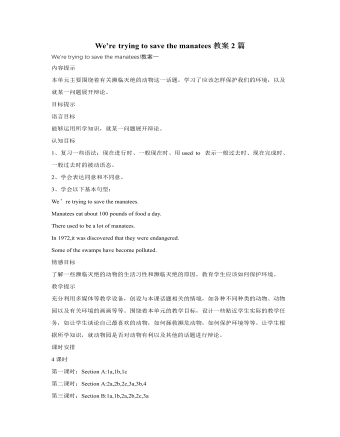
人教版新目标初中英语九年级下册We’re trying to save the manatees教案2篇
本单元主要围绕着有关濒临灭绝的动物这一话题,学习了应该怎样保护我们的环境,以及就某一问题展开辩论。目标提示语言目标能够运用所学知识,就某一问题展开辩论。认知目标1、复习一些语法:现在进行时、一般现在时、用used to 表示一般过去时、现在完成时、一般过去时的被动语态。2、学会表达同意和不同意。3、学会以下基本句型:We’re trying to save the manatees.Manatees eat about 100 pounds of food a day.There used to be a lot of manatees.In 1972,it was discovered that they were endangered.Some of the swamps have become polluted.情感目标了解一些濒临灭绝的动物的生活习性和濒临灭绝的原因,教育学生应该如何保护环境。教学提示充分利用多媒体等教学设备,创设与本课话题相关的情境,如各种不同种类的动物、动物园以及有关环境的画画等等。围绕着本单元的教学目标,设计一些贴近学生实际的教学任务,如让学生谈论自己最喜欢的动物,如何拯救濒危动物,如何保护环境等等。让学生根据所学知识,就动物园是否对动物有利以及其他的话题进行辩论。
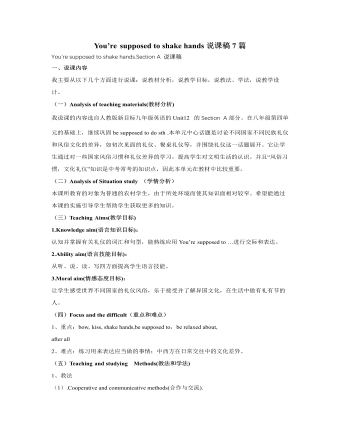
人教版新目标初中英语九年级下册You’re supposed to shake hands说课稿7篇
二 、教材分析本单元主要是通过对一些国家的风俗习惯、礼仪差异、时间观念和饮食文化的学习,进一步提高学生对文明生活的认识;加深学生对中外文化的了解,拓展学生的文化视野,为学生阅读相关方面的文章奠定一定的文化基础。我们知道近几年来有关风俗文化,生活习惯的 阅读内容一直是中考热门的话题之一。通过本单元的学习,学生可以掌握一定的相关方面的知识,为今后在阅读积累必要的信息。在Section A 当中出现的 be supposed to 句型为重点句型,此句型的语法结构为被动语态。被动语态也是历年来中考基础命题必考的内容之一。比如,去年的中考试题,在基础选择部分试题中就出现了对此语法结构考查。Section A 首先通过一些图片和句型来让学生初步了解本单元的语言目标。然后,通过练习进一步加以巩固。接着通过一组听力练习,来训练学生的听力,同时,学生可以具体了解到不同的国家在风俗习惯等方面有着怎样的不同。为下面的学习进行铺垫,同时激发学生了解更多的相关知识的学习兴趣。
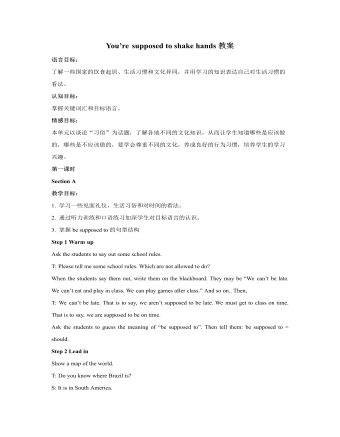
人教版新目标初中英语九年级下册You’re supposed to shake hands教案
教学目标:1. 掌握本单元一些重点词汇的写法和用法。2. 学会自如谈论餐桌礼仪。Step 1 RevisionAsk some students to retell the customs at the table in France in the passage in 3a.Step 2 Self checkPart 1. Fill in each bland with the correct word given. Students do the exercises by themselves at first. Then check the answers. Ask the students to comprehend the sentences and help them point out uses of some words, like “arrive (at / in) sw., spend time / money on sth , spend time / money (in) doing sth.”Part 2. Read about Fan Ling’s experience in a western restaurant. Understand the passage. Point out some key points in the passage.1. be / get used to doing sth. 习惯做某事2. begin with = start with 以….开头3. crowd v. 挤满,塞满 the crowd 人群 crowded adj. 拥挤的Then students discuss about how she would solve her problem. Ask some to share their stories with others.Part 3. Complete the crossword by looking at the sentences on the left. Then check the answers.
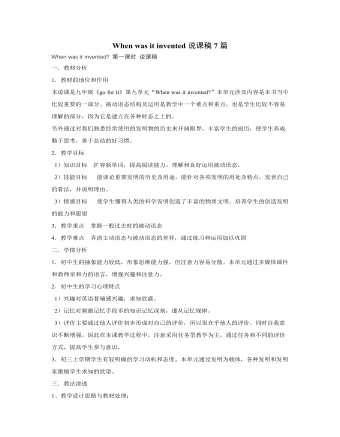
人教版新目标初中英语九年级下册When was it invented说课稿7篇
《新目标英语》中的具体语言目标是通过各种各样的Tasks来实现的;学生需要运用具体而特定的行动来完成一定的交际任务。整个教学过程中,各种语言结构与语言功能与不同的学习任务有机的结合。任务活动所谋求的效果不是一种机械的语言训练,而是侧重在执行任务中学生自我完成任务的能力和策略的培养;重视形式在完成任务过程中的参与和在交流活动中所获得的经验。因此本节课我将始终引导学生通过完成具体的任务活动来学习语言,让学生为了特定的学习目的去实施特定的语言行动,通过完成特定的交际任务来获得和积累相应的学习经验,让学生在用中学,在学中用。 2、教学原则 l 活动性原则 提倡学生主动参与,体验,交流,合作,探究等多种学习。 l 合作性原则 以学生为主体,师生合作,生生合作,体现教与学的互动,交往。 l 任务型原则 任务驱动—激发动机;任务完成—激励学习积极性;执行任务—培养责任 心和合作精神。 l 情感性原则 激发学生学习英语的兴趣和始终保持良好的学习情绪。
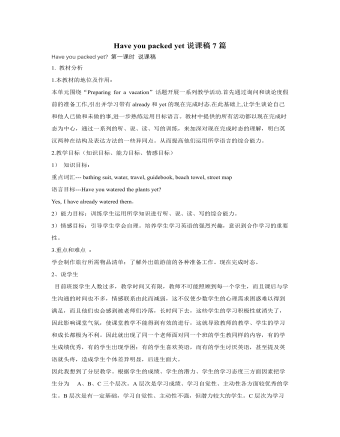
人教版新目标初中英语九年级下册Have you packed yet说课稿7篇
二 说学情 “以学生的发展为本”的新课程理念,要求教学必须以学生的学习基础、学生需要、学习兴趣等为出发点,联系学生的现代校内外生活,让课堂教学成为学生生命成长和个性张扬的过程。要实现以“学生为本”的理念,教学中必须要做到充分地预设学情。初三学生已经具备了一定的语言基础及语言表达能力,大部分学生对英语还有着比较浓厚的兴趣。同时,在长期的新课程理念熏陶及实践中,已经初步具备了自主,合作,探究的能力。本课教学内容与学生的实际生活密切相关,易于引发学生运用简单的英语进行交际和交流。通过八年级下册第九单元“Have you ever been to an amusement park?”的学习,学生已初步了解现在完成时的基本特征和结构,也比较熟悉“has/have been to…”的句型,这非常有利于本单元教学活动的开展。在此基础上,本单元以“Preparing for a vacation”和“Favorite band”等贴近学生实际生活的内容为话题,继续学习带有already与yet的现在完成时态,较快地激发学生的学习积极性,达成本单元的教学目标。
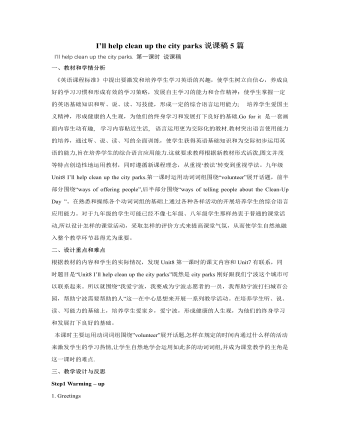
人教版新目标初中英语九年级下册I’ll help clean up the city parks说课稿5篇
二、教法学法1、任务型教学法:每个教学环节都是围绕着如何完成一个教学任务来设计的。2、感悟法:创设语境,让学生在一定的语言环境中感悟语言内涵,从而实现悟中学的目的。只有学生自己悟出的东西才能较好地内化为自己的东西。3、合作点拨法:通过教师创设的学习氛围,设置问题和反思质疑,推动师生,生生间的合作探究,小组合作学习,在解决问题中完成教学目标。以培养他们的合作探究的意识与精神。三、教学程序1 导入新课利用课件中的图片导入:在大屏幕上出示汶川大地震中一些悲惨的图片,让同学们说出汶川,然后老师说as well-know a stong earthquake happened in wenchuan,so many kind people go there to help others.再出示一些军人,医疗工作者,志愿者忙碌的身影,特别是温家宝总理看望受伤的孩子,让同学们知道一方有难,四方支持,帮助困难中的人是很有意义的。然后说Would you like to help others?What would you like to do?
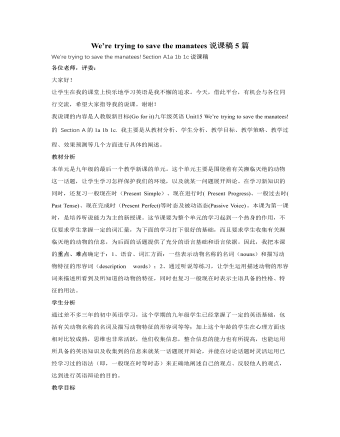
人教版新目标初中英语九年级下册We’re trying to save the manatees说课稿5篇
教材分析本单元是九年级的最后一个教学新课的单元。这个单元主要是围绕着有关濒临灭绝的动物这一话题,让学生学习怎样保护我们的环境,以及就某一问题展开辩论。在学习新知识的同时,还复习一般现在时(Present Simple)、现在进行时( Present Progress)、一般过去时( Past Tense)、现在完成时(Present Perfect)等时态及被动语态(Passive Voice)。本课为第一课时,是培养听说能力为主的新授课。这节课要为整个单元的学习起到一个热身的作用,不仅要求学生掌握一定的词汇量,为下面的学习打下很好的基础,而且要求学生收集有关濒临灭绝的动物的信息,为后面的话题提供了充分的语言基础和语言依据。因此,我把本课的重点、难点确定于:1、语音、词汇方面:一些表示动物名称的名词(nouns)和描写动物特征的形容词(description words);2、通过听说等练习,让学生运用描述动物的形容词来描述所看到及所知道的动物的特征,同时也复习一般现在时表示主语具备的性格、特征的用法。
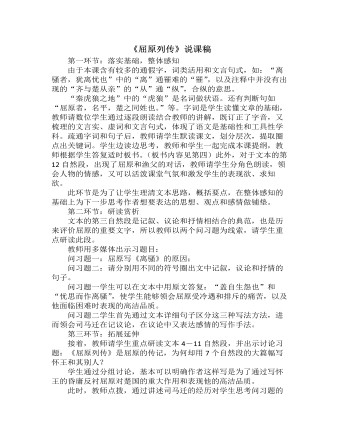
《屈原列传》说课稿 2021—2022学年统编版高中语文选择性必修中册
第一环节:落实基础,整体感知由于本课含有较多的通假字,词类活用和文言句式,如:“离骚者,犹离忧也”中的“离”通罹难的“罹”,以及注释中并没有出现的“齐与楚从亲”的“从”通“纵”,合纵的意思。 “秦虎狼之地”中的“虎狼”是名词做状语。还有判断句如“屈原者,名平,楚之同姓也。”等。字词是学生读懂文章的基础,教师请数位学生通过逐段朗读结合教师的讲解,既订正了字音,又梳理的文言实、虚词和文言句式,体现了语文是基础性和工具性学科。疏通字词和句子后,教师请学生默读课文,划分层次,提取圈点出关键词。学生边读边思考,教师和学生一起完成本课提纲,教师根据学生答复适时板书。(板书内容见第四)此外,对于文本的第12自然段,出现了屈原和渔父的对话,教师请学生分角色朗读,领会人物的情感,又可以活泼课堂气氛和激发学生的表现欲、求知欲。
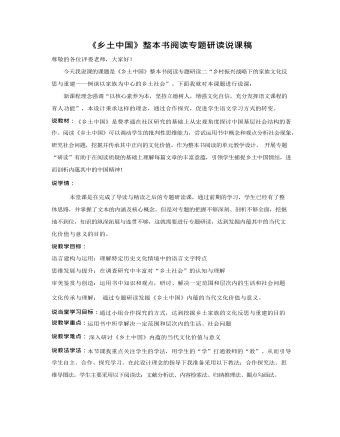
《乡土中国》说课稿 2021-2022学年统编版高中语文必修上册
活动一:整体感知,梳理要点新修订《课程标准》指出:重视学生的思维发展与提升,如直觉思维、形象思维、抽象思维等。为此,我设计了“梳理要点、绘制思维导图”两个部分,引导学生在阅读中整体感知文本。1、梳理章节要点,明确内容要素《家族》:以西洋家庭特点为对照,分析中国乡土社会家庭的特点。《男女有别》:主要讨论乡土社会感情定向的问题,偏向同性交往,遏制男女交往。2、展示思维导图,凸显整体关联引导同学制作多种思维导图:流程图式、树状图式、爪形图式活动二:走进文本,深化认知新修订《课程标准》指出:学会语文运用的方法,有效地提高语文能力,并在学习语言文字运用的过程中促进方法、习惯及情感、态度与价值观的综合发展。所以在教学中我引导学生掌握整本书阅读的基本方法,即以速读、跳读的方式地毯式地搜索书中关于“中西家庭差别”的内容,得出乡土家族的六个方面的特点,学生分别结合生活中的现象阐述了这六个方面的特点在生活中的具体体现。
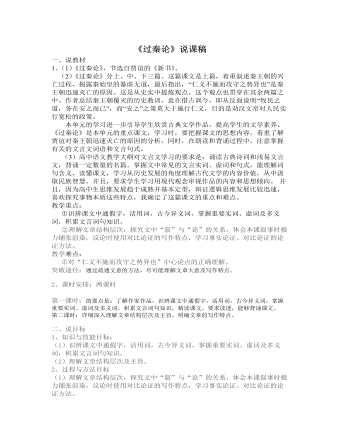
《过秦论》说课稿 2021—2022学年统编版高中语文选择性必修中册
三、教学方法为了突出重点,突破难点,完成教学目标,选择行之有效的教学方法是非常关键的。根据课程标准的要求和本节课的特点,为了关注学生的个体差异和不同的学习需求,充分调动学生学习的积极性,培养学生阅读和分析文章的能力,我主要采用以下的教学方法:1、悬念导入法。用悬念导入能激发起学生对文言文阅读的兴趣,充分调动学生学习的主动性。2、根据教师主导作用与学生主动性相结合的原则,选择了以语言传递信息为主的方法,讲授法。四、学法通过初中的学习,学生对古文知识已经有了一定的掌握,但是对这种古代散文比较少见,特别是叙史和议论结合的写法更是陌生。所以学习这篇课文的时候,通过反复地诵读,分析句型,对比句型的意思,达到疏通文意,这样,学生通过朗读理解法、质疑提问法、自主讨论探究法能复述课文,了解文章层次,理解文章主旨含义。
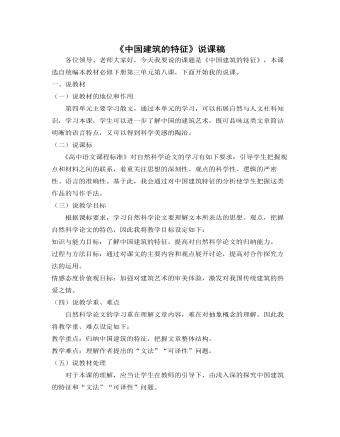
《中国建筑的特征》说课稿 2021—2022学年统编版高中语文必修下册
(二)初读课文,整体感知首先教师对作者进行简单介绍,再要求学生速读课文,让学生初步感知课文内容,归纳全文思路,边读边思考PPT上的问题。问题:全文可以分成几部分?此环节意在激发学生的学习主动性,培养学生的自学能力。读毕,我会对学生的自学情况进行检查反馈,鼓励学生踊跃发言,说出自己理解的写作思路,最后教师对学生的答案进行概括和总结,此环节能够让学生对中国建筑的特征整体把握,夯实学习本文的基础,同时感知课文,理清文章脉络,实现长文短教,为析读本文作好铺垫。(三)析读课文,质疑问难此环节是教学的重要阶段,在这里,我会以新课标为基准,做到阅读指向每一个学生的个体阅读,同时在教学过程中遵循启发性,循序渐进性的原则。此环节运用小组合作学习法、讨论法和问答法分析中国建筑的特征。同学每四人为一小组讨论PPT上展示的问题。
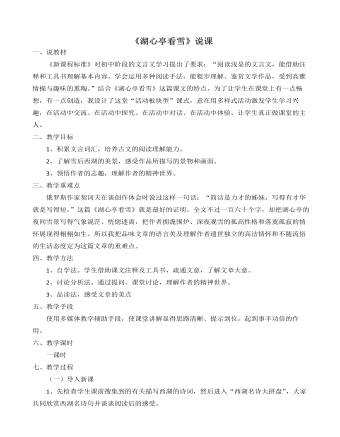
部编版语文九年级上册《湖心亭看雪》说课稿
一、说教材《新课程标准》对初中阶段的文言文学习提出了要求:“阅读浅显的文言文,能借助注释和工具书理解基本内容。学会运用多种阅读手法,能粗步理解、鉴赏文学作品,受到高雅情操与趣味的熏陶。”结合《湖心亭看雪》这篇课文的特点,为了让学生在课堂上有一点畅想,有一点创造,我设计了这堂“活动板块型”课式,意在用多样式活动激发学生学习兴趣,在活动中交流、在活动中探究、在活动中对话、在活动中体验,让学生真正做课堂的主人。二、教学目标1、积累文言词汇,培养古文的阅读理解能力。2、了解雪后西湖的美景,感受作品所描写的景物和画面。3、领悟作者的志趣,理解作者的精神世界。三、教学重难点俄罗斯作家契诃夫在谈创作体会时说过这样一句话:“简洁是力才的姊妹,写得有才华就是写得短。”这篇《湖心亭看雪》就是最好的证明。
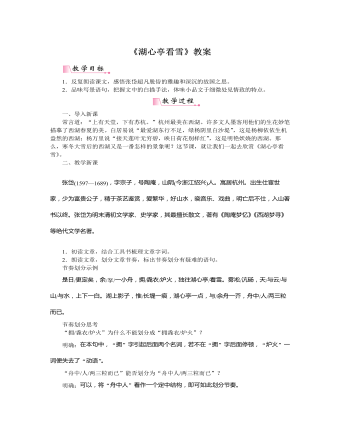
部编版语文九年级上册《湖心亭看雪》教案
一、导入新课常言道:“上有天堂,下有苏杭。”杭州最美在西湖。许多文人墨客用他们的生花妙笔描摹了西湖春夏的美。白居易说“最爱湖东行不足,绿杨阴里白沙堤”,这是杨柳依依生机盎然的西湖;杨万里说“接天莲叶无穷碧,映日荷花别样红”,这是明艳妖娆的西湖。那么,寒冬大雪后的西湖又是一番怎样的景象呢?这节课,就让我们一起去欣赏《湖心亭看雪》。二、教学新课目标导学一:认识作者,了解作品张岱(1597—1689),字宗子,号陶庵,山阴(今浙江绍兴)人。寓居杭州。出生仕宦世家,少为富贵公子,精于茶艺鉴赏,爱繁华,好山水,晓音乐、戏曲,明亡后不仕,入山著书以终。张岱为明末清初文学家、史学家,其最擅长散文,著有《陶庵梦忆》《西湖梦寻》等绝代文学名著。目标导学二:朗读训练,通文顺字1.初读文章,结合工具书梳理文章字词。2.朗读文章,划分文章节奏,标出节奏划分有疑难的语句。节奏划分示例
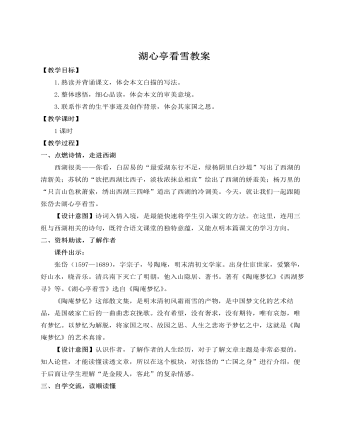
人教部编版语文九年级上册湖心亭看雪教案
《湖心亭看雪》是一篇审美型古文,其具体体现在文中的雪景和“痴”情的部分。尤其是文中“雾凇沆砀,天与云与山与水,上下一白,湖上影子,惟长堤一痕、湖心亭一点、与余舟一芥、舟中人两三粒而已”这文学作品中白描的经典之句,从整体到局部,由大到小,由远到近,实写与虚写交融,写出了作者视野的开阔,天地的空旷,人物的渺小,给人一种天地之大、人物之小、人于茫茫天地间如沧海一粟的深沉感慨。如此,给学生的审美和鉴赏提供了另外一种全新的方向:突出主体、不求细致、朴实无华。这种白描写法,可使景物描写的内涵更丰富,更能使情节发展和人物性格变化融合到环境中,使语言更有嚼头。白描用于写人,只需三言两语即可勾画出人物的外貌和神态,使读者如见其人,能洞穿人物骨髓,由貌触及本质、灵魂;能传神表达人物内心,展现情操品质;能使人物内心情感的表露更准确。这样的审美能力对学生创造更有真情实感的作品有更深远的影响。[疑难探究]
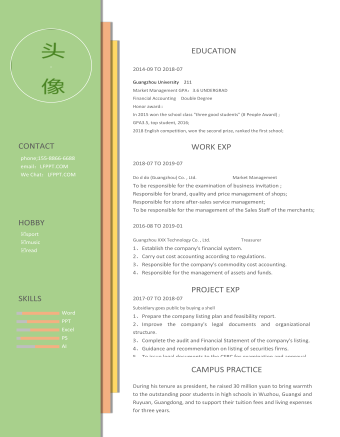
英文简历+中文简历
GuangzhouUniversity 211Market Management GPA:3.6 UNDERGRADFinancial Accounting Double DegreeHonor award::In 2015 won the school class"three good students" (# People Award) ;GPA3.5, top student, 2016;2018 English competition, won thesecond prize, ranked the first school;
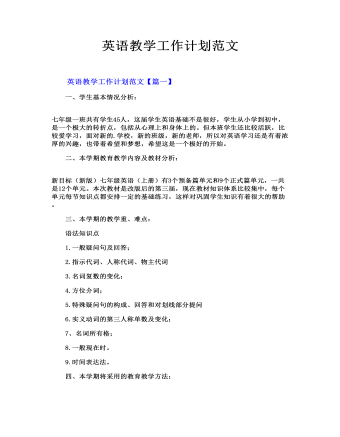
英语教学工作计划范文
1.用英语教英语(Teach English inEnglish); 英语毕竟是一门语言,训练的是学生的听、说、读、写、译的综合能力,在教学的过程中需要对学生的听、说、读、写、译的能力进行很多的训练,这就要求我们用英语来教英语,在课堂上对学生进行各种能力的训练。
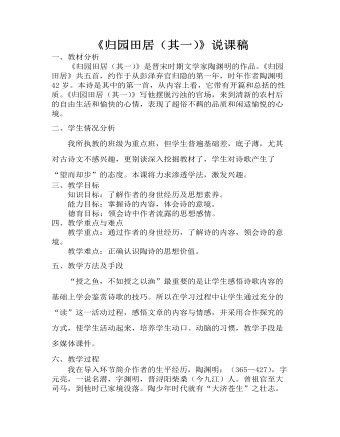
《归园田居(其一)》说课稿 2021-2022学年统编版高中语文必修上册
运用比较法,让学生讨论比较字词改换后与原诗在表达效果上有何异同,然后教师和同学们共同总结出原诗中的画线字词主要运用了比喻和拟人等修辞手法,显得既生动又含蓄,富有意境美,而改后的字词显得直白而又重复。通过文本研读部分的学习,学生对诗歌内容有了较深入的理解,为了使学生拓宽知识面,加强思想价值观的教育引导,在拓展练习部分我设置了一个探究性的问题,让学生谈谈如何看待陶渊明归隐的问题,我采用合作探究法,让学生分组互动讨论、自由发言。教师针对学生的发言,及时地加以点拨:陶渊明不与统治者合作,令人敬佩;歌唱田园风光,令人赞叹;归隐田园有独善其身,消极避世因素,这一点自然不应当苛求古人。
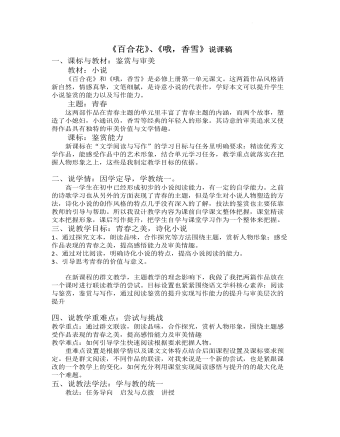
《百合花》《哦,香雪》说课稿 2022-2023学年统编版高中语文必修上册
1、导入:青春之美,弥足珍贵,青春的价值又各不相同,如果革命之志是毛泽东青春的美好,那蓬勃的创造力就是郭沫若的青春之歌,如果奉献与牺牲是闻一多青春的价值,那么自由就是雪莱青春的底色,我们前两节课遨游在诗歌的天空,那么我们这节课我们要来到小说的园地,看看青春在这片小说的沃土里展现怎样的颜色。目的:创设诗意,进入情境,延继单元主题,引出学习内容2、学习任务一:预习检查,概括情节目的:检查预习成果,落实整体感知把握主旨的课前学习任务。3、学习任务二:情境探究:品人物悟青春之美假设我校文学社正在举办“文学中最美的青春人物”评选活动,让同学在《百合花》与《哦,香雪》中推选出最能体现青春美好的人物,还需要附上简短的推荐理由以便评委组评议。谁最美?大家为此争论不休,如果你也参与推荐,那你觉得谁才是最美的青春人物?你会为他写上怎样的推荐理由?(思考提示:依据表格内容思考并完成表格,小组内交流3分钟,推选代表回答)


